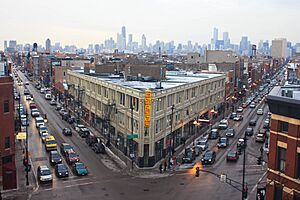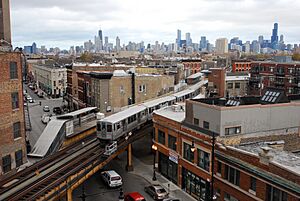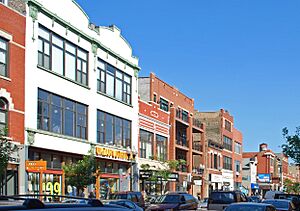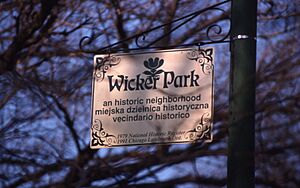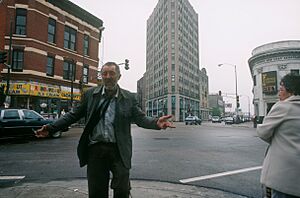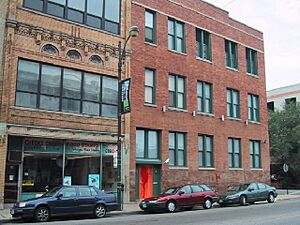Wicker Park, Chicago facts for kids
Wicker Park is a lively neighborhood in the West Town area of Chicago, Illinois. It's located on the city's West Side, west of the Kennedy Expressway, east of Humboldt Park, and south of the Bloomingdale Trail. This area is famous for its cool culture, art scene, fun nightlife, and amazing food.
Wicker Park has grown a lot with new buildings and shops, especially near the CTA Blue Line subway. You can find many fancy shops and big retail stores here. Homes in Wicker Park are some of the most expensive in Chicago.
Contents
Where is Wicker Park?
The neighborhood is northwest of The Loop, which is downtown Chicago. It's north of East Village and Ukrainian Village, east of Humboldt Park, and south of Bucktown. A 4-acre park, also called Wicker Park, is a popular outdoor spot in the neighborhood.
The main boundaries of Wicker Park are usually considered to be the Bloomingdale Trail (also known as the 606) to the north, Ashland Avenue to the east, Division Street to the south, and Western Avenue to the west.
The Wicker Park Historic District is a special area listed on the National Register of Historic Places listings in Chicago. Many parts of Wicker Park are also recognized as a Chicago Landmark District. This means they are important historical places.
History of Wicker Park
How Wicker Park Started (1800s)
In 1868, Chicago leaders wanted to build a park west of Milwaukee Avenue and south of North Avenue. Two brothers, Charles and Joel Wicker, bought 80 acres of land in 1870. They created a neighborhood around a 4-acre park. The Great Chicago Fire in 1871 helped the area grow, as many people needed new homes.
By the end of the 1800s, many wealthy immigrants from Germany and Norway moved to Wicker Park. They built large, beautiful houses, especially on Hoyne and Pierce streets. Hoyne Street was even called "Beer Baron Row" because many rich brewers lived there.
Around 1900
As the 19th century ended, more people moved into the area. Many immigrants from Poland came, and the new train lines made the area even more crowded. The part of Wicker Park next to the Polish Downtown became known as the "Polish Gold Coast." The area around Division, Milwaukee, and Ashland streets was once called "Kostkaville." Today, this intersection is still known as the "Polonia Triangle – Polish Triangle."
The 1900s
During World War I, the temporary government of Poland even met in Wicker Park. Many grand churches were built in the area by the Archdiocese of Chicago, showing off beautiful architectural styles.
1930s–1950s
More Polish immigrants arrived during and after World War II. Many of them were Displaced Persons (DPs) who had to leave their homes. They settled in Wicker Park because it had shops, restaurants, and banks where people spoke their language. Division Street was even called Polish Broadway. A poet named John Guzlowski, whose parents came to the area as DPs, said that growing up in the 1950s, "it felt like everyone was a Pole."
The writer Nelson Algren wrote about Division Street in his famous books like The Man with the Golden Arm.
1960s–1970s
In the 1960s, Wicker Park started to change a lot. The Kennedy Expressway was built in 1960, which forced many people to move and broke up some community ties. Also, Puerto Ricans and other Latinos moved to Wicker Park after being displaced from other neighborhoods. By 1970, Latinos made up 39 percent of West Town's population.
Community groups like the Young Lords worked with local gangs like the Latin Kings to help the community. They organized peaceful protests for human rights. The city also tried to improve some parts of the neighborhood. However, many banks stopped investing in West Town, and many small factories closed. This led to more unemployment and a difficult time for the area.
1980s–1990s
In the 1980s, community groups worked to build new affordable homes. At the same time, artists started moving to Wicker Park. They liked that it was close to downtown, had cheap loft spaces in old factories, and felt very urban.
In 1989, the "Around the Coyote" festival began. It was created to help local artists and small art galleries become more well-known. This festival was usually held in October, Chicago's Artist Month, and centered around the Flatiron Arts Building. After 2008, "Around the Coyote" moved downtown and was renamed Looptopia. Many local artists also moved to other art communities in Chicago.
Wicker Park Today (2000s)
Today, Wicker Park is known for its many shops, restaurants, and entertainment spots. It's a great place for people who work downtown because it's close to public transportation. In 2001, MTV's reality TV show The Real World: Chicago was filmed in Wicker Park. This caused some protests because people felt it was promoting changes in the neighborhood that made it harder for long-time residents to stay.
In the last two decades, crime has gone down, and many new homes have been built or old ones fixed up. This has led to more businesses opening. The neighborhood is very trendy, with new bands, fashion boutiques, gourmet restaurants, European-style cafes, and artsy businesses.
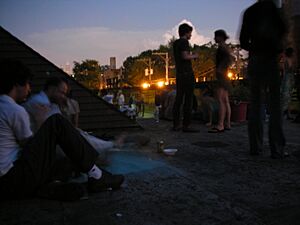
In a 2012 Forbes article, Wicker Park was named the #4 "hippest" neighborhood in the country.
Property values and taxes have been increasing in Wicker Park. In 2016, the average tax increase was 28.1% in Wicker Park. New projects, like the Bloomingdale Trail (also known as The 606), have also helped property values go up and encouraged other big developments.
Schools in Wicker Park
Students in Wicker Park attend various schools that are part of the Chicago Public Schools district.
- A. N. Pritzker School, which used to be called Wicker Park School, is a performing arts school for elementary and middle school students.
- Sabin Dual Language Magnet School is a special school that teaches in two languages.
- Jonathan Burr Elementary School serves students from Kindergarten through 8th grade.
- LaSalle II Magnet School is a magnet school that focuses on world languages.
Culture and Entertainment
Famous Residents
Some well-known people who have lived or currently live in Wicker Park include:
- Nelson Algren, a local author.
- Colt Cabana, a professional wrestler.
- CM Punk, a professional wrestler.
- Hannibal Buress, a comedian.
- Carrie Coon and Tracy Letts, actors.
Many famous musicians have also lived or worked in Wicker Park, such as:
- Liz Phair, a singer-songwriter, who wrote her first album Exile in Guyville here.
- James Iha, guitarist for the band Smashing Pumpkins.
- Matt Skiba, singer/guitarist of The Alkaline Trio.
- Other bands include Wilco, Joan of Arc (band), Naked Raygun, Tortoise, and Veruca Salt.
Wicker Park in Media
In 2001, a season of MTV's The Real World, called The Real World: Chicago, was filmed in Wicker Park.
The 2004 film of the same name is set in Wicker Park, but it was actually filmed in Montreal, Quebec. Another notable movie that used Wicker Park as its background is High Fidelity (2000), starring John Cusack.
In 2015, parts of the Spike Lee movie Chiraq were filmed in Wicker Park. The Chicago-based TV shows like Shameless and the NBC Chicago series (Chicago Fire, Chicago P.D., and Chicago Med) often film scenes in Wicker Park.
The Irazu Costa Rica Restaurant on Milwaukee Avenue has been featured on TV shows like PBS's Check, Please! and Food Network's Diners, Drive-ins and Dives.


